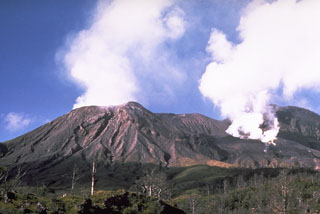Report on Langila (Papua New Guinea) — September 1978
Scientific Event Alert Network Bulletin, vol. 3, no. 9 (September 1978)
Managing Editor: David Squires.
Langila (Papua New Guinea) Vulcanian activity; one or two large explosions/day
Please cite this report as:
Global Volcanism Program, 1978. Report on Langila (Papua New Guinea) (Squires, D., ed.). Scientific Event Alert Network Bulletin, 3:9. Smithsonian Institution. https://doi.org/10.5479/si.GVP.SEAN197809-252010
Langila
Papua New Guinea
5.525°S, 148.42°E; summit elev. 1330 m
All times are local (unless otherwise noted)
"An eruptive phase which began in late April and intensified markedly in late May has continued to the present (25 September). However, a volcanological party observed the activity from 30 May-9 June and found that it was not Strombolian as suggested by early reports, but Vulcanian in character. Typically, one or two larger explosions occurred per day, with a number of lesser ones. A lull was noted during mid-July and from late August. Since the first week of September, there has been little activity."
Geological Summary. Langila, one of the most active volcanoes of New Britain, consists of a group of four small overlapping composite basaltic-andesitic cones on the lower E flank of the extinct Talawe volcano in the Cape Gloucester area of NW New Britain. A rectangular, 2.5-km-long crater is breached widely to the SE; Langila was constructed NE of the breached crater of Talawe. An extensive lava field reaches the coast on the N and NE sides of Langila. Frequent mild-to-moderate explosive eruptions, sometimes accompanied by lava flows, have been recorded since the 19th century from three active craters at the summit. The youngest and smallest crater (no. 3 crater) was formed in 1960 and has a diameter of 150 m.
Information Contacts: R. Cooke, RVO.

